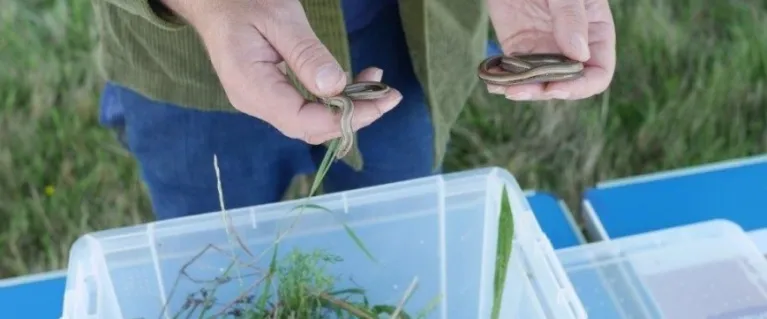
Rewilding for Reptiles
Funding overview
- Organisation name: The Land Restoration Trust
- Project name: Rewilding for Reptiles
- Grant awarded: £35,160
- Total project cost: £44,270
- Area: Barking and Dagenham
- Project aim: To monitor the reptile and amphibian population by engaging with local communities
About the project
Beam Parklands is a 53-hectare site rich in biodiversity, including reptiles and amphibians. This is important because the population range and numbers of these animals have decreased in many parts of London.
The funding allowed The Land Restoration Trust to undertake a programme of works to identify and increase reptile and amphibian populations, as well as carry out important habitat work to benefit a broad range of species along the Dagenham Corridor. The project can now be used as a template for other sites across London where habitats could be improved to increase reptile populations.

Volunteers and staff received training in surveying reptiles and amphibians from London, Essex and Hertfordshire Amphibian and Reptile Trust. This training was crucial as it enabled the volunteers to effectively help the Trust to conduct surveys. It also helped to reduce any fear or misconceptions about reptiles among the volunteers.
Impact on London's environment
The project was multifaceted, involving public engagement, species surveys and on-the-ground improvements to an already rich environment of woodland, a river, acid grassland and ponds.
Training communities on the benefits of reptiles and amphibians makes it less likely that these species will be feared or persecuted, and enables local residents to enjoy their local green spaces in harmony with the creatures that these spaces are home to.
Other species on site include water voles, great crested newts and emperor dragonflies.
Key learnings
-
The collaboration between the trained volunteers and the Trust highlights the importance of training, ensuring accurate and efficient survey results, and promoting a better understanding of these creatures.
-
The focus on key species and learning about their habitats are crucial for other parts of London where species reintroduction or a drive to increase population densities is planned.
Need a document on this page in an accessible format?
If you use assistive technology (such as a screen reader) and need a version of a PDF or other document on this page in a more accessible format, please get in touch via our online form and tell us which format you need.
It will also help us if you tell us which assistive technology you use. We’ll consider your request and get back to you in 5 working days.